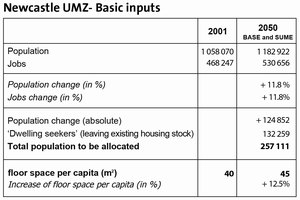Bound to the east by the North Sea, the area around the Tyne and Wear Rivers urbanised during the 19th century. Driven primarily by industrial development, the result was a relatively dense urban core of heavy industry along the rivers, surrounded by residential areas. Over the past 50 years, the forces of globalisation have reshaped Newcastle's economy; away from heavy industry and mining and towards the service and knowledge economy.
Economic change has contributed to a large supply of underused economic and residential buildings in the city core and sprawled development toward the margins of the city. As a result, the inner city of Newcastle – while containing a vibrant commercial zone - is characterised as being hollowed out and faces significant socio-economic problems such as high unemployment, poverty, deprivation and the complete market collapse of some neighbourhoods. This has prompted people and businesses to shift their investment toward the suburbs in search of better conditions, which has a direct impact on car dependency. Despite having a local Metro, commuting ridership was most recently measured at 21% in 2001.
The population of Newcastle fell by 5% between 1981 and 2008; however it has begun to rebound and is expected to return to its 1981 level by 2030. A population increase from the current 1 060 000 to 1 180 000, coupled with a per capita increase of living space per person, from 40m2 to 45m2 means that there will be approximately 260 000 dwelling seekers between now and 2050. Efforts to respond to this growth by re-focussing development inward toward the city centre exist, yet inner-city projects are confronted by competition from suburban communities offering large detached and semi-detached homes.
While the policy discourse in Newcastle indicates the existence of a more resource-aware planning mentality, the reality is that planning ideals and market forces continue to dovetail. Currently, there are no specific plans to extend Metro coverage in Newcastle due to the lack of available public capital, and the demand for detached housing with private gardens is exacerbating urban sprawl. As a result, the continuation of the status quo will require an additional 15km2 of urban expansion to distribute the 65 000 residents who will not fit into the existing UMZ. Considering the large plots of land available for redevelopment and the relatively slow growth rate in Newcastle, this is a significant expansion.
However, this pattern can be reversed if planners and policy makers are able to facilitate a transition toward more resource-aware approaches based on public transit provision and higher density living. The SUME perspective not only indicates that growth can be accommodated within the current UMZ, but space for an additional 45 000 residents would be provided through the redevelopment of existing underused neighbourhoods.
Northward view of Newcastle's city centre across the River Tyne. While the immediate city centre acts as a robust hub of social and economic activity, the surrounding inner city is plagued by insufficient building quality and failing housing markets.


Northward view of Newcastle's city centre across the River Tyne. While the immediate city centre acts as a robust hub of social and economic activity, the surrounding inner city is plagued by insufficient building quality and failing housing markets.